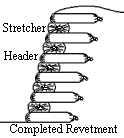 Sandbags
were canvass bags about 32 inches long and 14 inches wide when empty and
when filled and tied about 27 inches long and 9 inches in diameter. A good
sandbag revetment would be formed of courses that followed a pattern of
alternating headers and stretchers, though in practice this pattern was often
altered according incumbent necessity, economy, or simple ignorance into
all stretchers or all headers. As with any revetment of stacked material
joints between sandbags would be covered by successive courses. The initial
course could either be laid level or at an angle to follow the incline of
the interior slope; when laid level, successive courses had to be laid with
the interior slope side slightly back from preceeding Sandbags
were canvass bags about 32 inches long and 14 inches wide when empty and
when filled and tied about 27 inches long and 9 inches in diameter. A good
sandbag revetment would be formed of courses that followed a pattern of
alternating headers and stretchers, though in practice this pattern was often
altered according incumbent necessity, economy, or simple ignorance into
all stretchers or all headers. As with any revetment of stacked material
joints between sandbags would be covered by successive courses. The initial
course could either be laid level or at an angle to follow the incline of
the interior slope; when laid level, successive courses had to be laid with
the interior slope side slightly back from preceeding
 courses to
form the angle of the interior slope. Soil forming the body of the parapet
was well rammed behind each course of sandbags as it was completed. courses to
form the angle of the interior slope. Soil forming the body of the parapet
was well rammed behind each course of sandbags as it was completed.
 Sandbags
tended to deteriorate much more rapidly than other more solid revetment materials
and were not considered suitable for use as a revetment in field works that
would be occupied for a prolonged period of time. But they were considered
an effective option when other revetment materials were either unsuited to
the soil or could not be procured without great difficulty. Many of the Federal
siege batteries on Morris Island, South Carolina, for instance, were revetted
with sandbags since plank wood was difficult to obtain and other types of
revetments that could be raised quickly could not be relied on to retain
sand without excessive seepage. Sandbags were used to form entire parapets
when works had to be thrown up with great rapidity and when soil at the site
(particularly in marshes and when the soil was very thin) was unsuited to
the formation of a sound parapet. Sandbags
tended to deteriorate much more rapidly than other more solid revetment materials
and were not considered suitable for use as a revetment in field works that
would be occupied for a prolonged period of time. But they were considered
an effective option when other revetment materials were either unsuited to
the soil or could not be procured without great difficulty. Many of the Federal
siege batteries on Morris Island, South Carolina, for instance, were revetted
with sandbags since plank wood was difficult to obtain and other types of
revetments that could be raised quickly could not be relied on to retain
sand without excessive seepage. Sandbags were used to form entire parapets
when works had to be thrown up with great rapidity and when soil at the site
(particularly in marshes and when the soil was very thin) was unsuited to
the formation of a sound parapet.
[This page originall appeared as a Detailed Notes Page on the
old Civil War Field Fortifications Website.] |